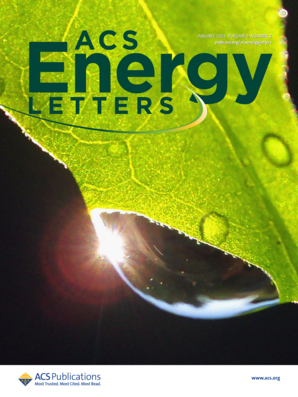Quantum Dot Enabled Cation Exchange in Halide Perovskites for Photovoltaics and Infrared Photodetectors
IF 19.3
1区 材料科学
Q1 CHEMISTRY, PHYSICAL
引用次数: 0
Abstract
Tailoring the photophysical properties of halide perovskites is a promising strategy to simultaneously address defects, modulate carrier dynamics, and expand the spectral response. Quantum dots (QDs) are promising candidates to functionalize perovskites; however, the interaction mechanisms between robust-lattice QDs and ionic perovskites remain unclear. Here, we pioneer a cation exchange approach using CdSe QDs to functionalize lead halide perovskites, where Cd2+ replaces Pb2+ and diffuses throughout the perovskite matrix. This cation exchange achieves dual benefits: (1) efficient defect passivation via Cd2– diffusion and Se2– coordination with undercoordinated Pb2+, and (2) extended infrared light response up to 1200 nm attributed to in situ formed PbSe QDs. The champion perovskite solar cells delivered a power conversion efficiency of 24.8%, significantly outperforming the control devices (23.0%). Moreover, infrared PbSe QDs formed enable broadband detection to infrared spectrum (300–1200 nm), with a detectivity of 2.9 × 1011 Jones at 1170 nm under −0.3 V bias. Extension of this strategy to CdS QDs further confirmed this cation exchange mechanism. Therefore, our work establishes a versatile, scalable interface-engineering method between robust-lattice QDs and perovskites, paving the way for multifunctional optoelectronic applications.光电和红外光电探测器中卤化钙钛矿中量子点使能阳离子交换
调整卤化物钙钛矿的光物理性质是一种很有前途的策略,可以同时解决缺陷,调节载流子动力学,扩大光谱响应。量子点(QDs)是很有前途的钙钛矿功能化候选者;然而,强健晶格量子点与离子钙钛矿之间的相互作用机制尚不清楚。在这里,我们首创了一种阳离子交换方法,使用CdSe量子点来功能化卤化铅钙钛矿,其中Cd2+取代Pb2+并扩散到整个钙钛矿基质中。这种阳离子交换获得了双重好处:(1)通过Cd2 -扩散和Se2 -与欠配位的Pb2+有效地钝化缺陷;(2)原位形成的PbSe量子点将红外光响应扩展到1200 nm。冠军钙钛矿太阳能电池的功率转换效率为24.8%,显著优于控制装置(23.0%)。此外,形成的红外PbSe量子点可以实现对红外光谱(300-1200 nm)的宽带探测,在- 0.3 V偏置下,在1170 nm处的探测率为2.9 × 1011 Jones。将该策略扩展到CdS量子点进一步证实了这种阳离子交换机制。因此,我们的工作在强健晶格量子点和钙钛矿之间建立了一种通用的、可扩展的界面工程方法,为多功能光电应用铺平了道路。
本文章由计算机程序翻译,如有差异,请以英文原文为准。
求助全文
约1分钟内获得全文
求助全文
来源期刊

ACS Energy Letters
Energy-Renewable Energy, Sustainability and the Environment
CiteScore
31.20
自引率
5.00%
发文量
469
审稿时长
1 months
期刊介绍:
ACS Energy Letters is a monthly journal that publishes papers reporting new scientific advances in energy research. The journal focuses on topics that are of interest to scientists working in the fundamental and applied sciences. Rapid publication is a central criterion for acceptance, and the journal is known for its quick publication times, with an average of 4-6 weeks from submission to web publication in As Soon As Publishable format.
ACS Energy Letters is ranked as the number one journal in the Web of Science Electrochemistry category. It also ranks within the top 10 journals for Physical Chemistry, Energy & Fuels, and Nanoscience & Nanotechnology.
The journal offers several types of articles, including Letters, Energy Express, Perspectives, Reviews, Editorials, Viewpoints and Energy Focus. Additionally, authors have the option to submit videos that summarize or support the information presented in a Perspective or Review article, which can be highlighted on the journal's website. ACS Energy Letters is abstracted and indexed in Chemical Abstracts Service/SciFinder, EBSCO-summon, PubMed, Web of Science, Scopus and Portico.
 求助内容:
求助内容: 应助结果提醒方式:
应助结果提醒方式:


